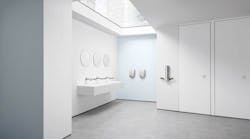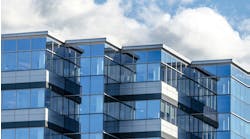An advanced generation of hand dryers that save time, money and energy has made its way into the commercial restroom. Meet the Dyson Airblade 9kJ, the newest addition to the appliance company’s Airblade line that originally launched in 2006. It’s the quietest and most energy efficient of all Dyson’s Airblade products, according to the company.
“We strive to make our machines as cost effective as possible for our partners without compromising on efficiency,” says Anthony Hall, one of Dyson’s advanced design engineers that worked closely on the Airblade 9kJ.
It took the Dyson team more than three years of development and 700-plus prototypes to create the hand dryer. It’s the first Dyson Airblade to feature two modes:
1. Max mode is designed for washrooms with high footfall that want to optimize for speed, such as airports and stadiums.
2. Eco mode is recommended for washrooms with relatively lower footfall, like offices or restaurants, who want to optimize for energy consumption and noise reduction.
Hall says both modes provide benefits to bathrooms and their users. When in Max mode, the Airblade 9kJ has a 10-second dry time; when in Eco mode, it uses 86% less energy than traditional warm air dryers and costs around $19 per year to run.
It’s ideal for companies looking to be environmentally conscious, as it produces up to 85% less carbon dioxide emissions per day than paper towels in addition to saving significant operating costs.
Upgrades to the Airblade
Hall notes the efficient dry time is attributed to the Airblade 9kJ’s signature Curved Blade design. A Dyson digital motor spins up to 75,000 times a minute, powering two curved apertures. Together they create 388-mph sheets of air that follow the contours of your hands, removing water faster than any other Dyson dryer.
[Related: Products That Save You Money]
“Many calculations were carried out by Dyson engineers to determine a more ergonomic drying angle,” he says. “The blades are positioned at 70 degrees for fast, comfortable hand drying.” (Photo: Cutaway Credit: Dyson)
The Airblade 9kJ’s design was also acoustically engineered to be the quietest model. Hall says the design team went to great lengths to achieve noise reduction, including:
- The machine’s straight-line configuration, which creates a simpler airflow path, reducing air turbulence and therefore reducing sound output. This new design also results in less energy consumption.
- The motor housing of the Dyson digital motor V4, which regulates airflow paths to reduce noisy turbulence. Hall says the motor is also mounted on silicone rubber to further reduce noise and the open-cell foam silencers absorb vibrations from air entering and exiting the motor.
One thing that has remained constant among all Airblade designs is Dyson’s use of HEPA filters within each dryer. A fleece-lined glass fiber HEPA filter captures 99.97% of particles, including bacteria and viruses from the washroom air, according to the product’s overview.
“In restrooms where there is an excess of germs, hygiene is critically important,” Hall says. “Without the capability to filter the air, other hand dryers are simply concentrating the dirty air and blowing it directly on your hands.”
Better for Business
Learn how Dyson’s Airblade 9kJ hand dryer can create a better environment in the washroom and the world outside through the numbers below.
- 700+ Prototypes made over three years
- 10 Seconds it takes the Dyson Airblade 9kJ to dry hands
- 6.1 Gallons of air shifted per second through the digital motor when in Max mode
- 86% Less energy usage than warm air dryers when in Eco mode
- 85% Less carbon dioxide emissions per day than paper towels
- 2006 Launch of the first Dyson Airblade
- 2 Modes of operation: Max and Eco
- 70 Degree of angle for the Dyson Airblade 9kJ’s blades
- $19 Average annual cost of operation when operating in Eco mode
- .25 Seconds the sensors are calibrated to detect hands
- 99.97% Amount of particles that are captured through a fleece-lined glass fiber HEPA filter
Two handpicked articles to read next:



